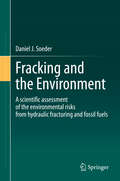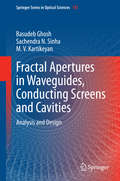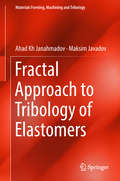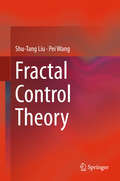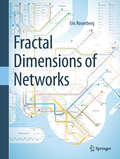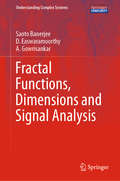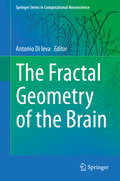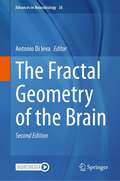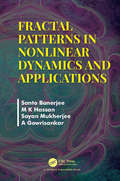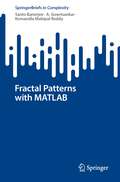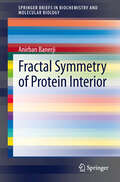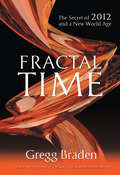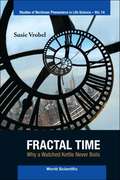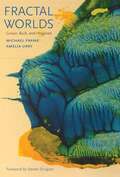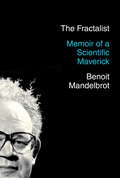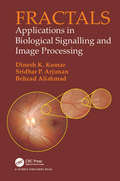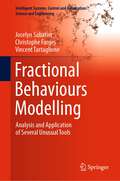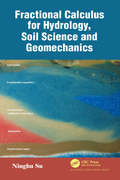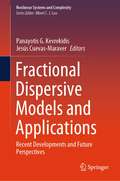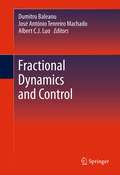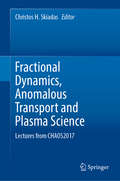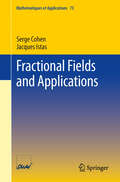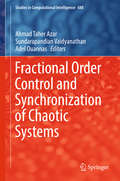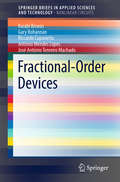- Table View
- List View
Fracking and the Environment: A scientific assessment of the environmental risks from hydraulic fracturing and fossil fuels
by Daniel J. SoederThis book provides a systematic scientific approach to the understanding of hydraulic fracturing (fracking) as a hydrocarbon extraction technology and its impact on the environment. The book addresses research from the past decade to assess how fracking can affect air, water, landscapes and ecosystems, and presents the subject in the context of the history of fracking and shale gas development in the United States, describing what is known and not known about environmental impacts, and the broader implications of fossil energy use, climate change, and technology development. In 9 chapters, the author lays out how and why hydraulic fracturing was developed, what driving forces existed at the beginning of the so-called "shale revolution", how success was achieved, and when and why public acceptance of the technology changed. The intended audience is scientific people who are concerned about fracking, but perhaps do not know all that much about it. It is also intended for lay people who would be interested in understanding the technical details of the process and what effects it might or might not be having on the environment. The book is written at a level that is both understandable and technically correct. A further goal is to give some useful insights even to experienced petroleum geologists and engineers who have been doing fracking for many years.
Fractal Apertures in Waveguides, Conducting Screens and Cavities
by Basudeb Ghosh Sachendra N. Sinha M. V. KartikeyanThis book deals with the design and analysis of fractal apertures in waveguides, conducting screens and cavities using numerical electromagnetics and field-solvers. The aim is to obtain design solutions with improved accuracy for a wide range of applications. To achieve this goal, a few diverse problems are considered. The book is organized with adequate space dedicated for the design and analysis of fractal apertures in waveguides, conducting screens and cavities, microwave/millimeter wave applications followed by detailed case-study problems to infuse better insight and understanding of the subject. Finally, summaries and suggestions are given for future work. Fractal geometries were widely used in electromagnetics, specifically for antennas and frequency selective surfaces (FSS). The self-similarity of fractal geometry gives rise to a multiband response, whereas the space-filling nature of the fractal geometries makes it an efficient element in antenna and FSS unit cell miniaturization. Until now, no efforts were made to study the behavior of these fractal geometries for aperture coupling problems. The aperture coupling problem is an important boundary value problem in electromagnetics and used in waveguide filters and power dividers, slotted ground planes, frequency selective surfaces and metamaterials. The present book is intended to initiate a study of the characteristics of fractal apertures in waveguides, conducting screens and cavities. To perform a unified analysis of these entirely dissimilar problems, the "generalized network formulation of the aperture problems" by Mautz and Harrington was extended to multiple-aperture geometry. The authors consider the problem of coupling between two arbitrary regions coupled together via multiple apertures of arbitrary shape. MATLAB codes were developed for the problems and validated with the results available in the literature as well as through simulations on ANSOFT's HFSS.
Fractal Approach to Tribology of Elastomers (Materials Forming, Machining and Tribology)
by Ahad Kh Janahmadov Maksim JavadovThis book summarizes the results of years of research on the problem of strength and fracture of polymers and elastomers. It sets out the modern approach to the strength theory from the standpoint of fractals, the kinetic and thermodynamic theories as well as the meso-mechanic destruction. The dimension reduction method is applied to model the friction processes in elastomers subjected to the complex dynamic loading. Finally, it analyses a relation between the fracture mechanism and the relation phenomena, and provides new experimental data on the sealing nodes in accordance with their specific working conditions where the effect of self-sealing is observed.
Fractal Control Theory
by Shu-Tang Liu Pei WangThis book focuses on the control of fractal behaviors in nonlinear dynamics systems, addressing both the principles and purposes of control. For fractals in different systems, it presents revealing studies on the theory and applications of control, reflecting a spectrum of different control methods used with engineering technology. As such, it will benefit researchers, engineers, and graduate students in fields of fractals, chaos, engineering, etc.
Fractal Dimensions of Networks (Springerbriefs In Computer Science Ser.)
by Eric RosenbergCurrent interest in fractal dimensions of networks is the result of more than a century of previous research on dimensions. Fractal Dimensions of Networks ties the theory and methods for computing fractal dimensions of networks to the “classic” theory of dimensions of geometric objects.The goal of the book is to provide a unified treatment of fractal dimensions of sets and networks. Since almost all of the major concepts in fractal dimensions originated in the study of sets, the book achieves this goal by first clearly presenting, with an abundance of examples and illustrations, the theory and algorithms for sets, and then showing how the theory and algorithms have been applied to networks. Thus, the book presents the classical theory and algorithms for the box counting dimension for sets, and then presents the box counting dimension for networks. All the major fractal dimensions are studied, e.g., the correlation dimension, the information dimension, the Hausdorff dimension, the multifractal spectrum, as well as many lesser known dimensions. Algorithm descriptions are accompanied by worked examples, many applications of the methods are presented, and many exercises, ranging in difficulty from easy to research level, are included.
Fractal Functions, Dimensions and Signal Analysis (Understanding Complex Systems)
by Santo Banerjee D. Easwaramoorthy A. GowrisankarThis book introduces the fractal interpolation functions (FIFs) in approximation theory to the readers and the concerned researchers in advanced level. FIFs can be used to precisely reconstruct the naturally occurring functions when compared with the classical interpolants. The book focuses on the construction of fractals in metric space through various iterated function systems. It begins by providing the Mathematical background behind the fractal interpolation functions with its graphical representations and then introduces the fractional integral and fractional derivative on fractal functions in various scenarios. Further, the existence of the fractal interpolation function with the countable iterated function system is demonstrated by taking suitable monotone and bounded sequences. It also covers the dimension of fractal functions and investigates the relationship between the fractal dimension and the fractional order of fractal interpolation functions. Moreover, this book explores the idea of fractal interpolation in the reconstruction scheme of illustrative waveforms and discusses the problems of identification of the characterizing parameters. In the application section, this research compendium addresses the signal processing and its Mathematical methodologies. A wavelet-based denoising method for the recovery of electroencephalogram (EEG) signals contaminated by nonstationary noises is presented, and the author investigates the recognition of healthy, epileptic EEG and cardiac ECG signals using multifractal measures. This book is intended for professionals in the field of Mathematics, Physics and Computer Science, helping them broaden their understanding of fractal functions and dimensions, while also providing the illustrative experimental applications for researchers in biomedicine and neuroscience.
The Fractal Geometry of the Brain
by Antonio Di IevaReviews the most intriguing applications of fractal analysis in neuroscience with a focus on current and future potential, limits, advantages, and disadvantages. Will bring an understanding of fractals to clinicians and researchers also if they do not have a mathematical background, and will serve as a good tool for teaching the translational applications of computational models to students and scholars of different disciplines. This comprehensive collection is organized in four parts: (1) Basics of fractal analysis; (2) Applications of fractals to the basic neurosciences; (3) Applications of fractals to the clinical neurosciences; (4) Analysis software, modeling and methodology.
The Fractal Geometry of the Brain (Advances in Neurobiology #36)
by Antonio Di IevaThe new edition of the highly popular, The Fractal Geometry of the Brain, reviews the most intriguing applications of fractal analysis in neuroscience with a focus on current and future potential, limits, advantages, and disadvantages. It brings an understanding of fractals to clinicians and researchers even if they do not have a mathematical background, and it serves as a valuable tool for teaching the translational applications of computational fractal-based models to both students and scholars. As a consequence of the novel research developed at Professor Di Ieva's laboratory and other centers around the world, the second edition will explore the use of computational fractal-based analysis in many clinical disciplines and different fields of research, including neurology and neurosurgery, neuroanatomy and psychology, magnetoencephalography (MEG), eye-tracking devices (for the fractal computational characterization of “scanpaths”),deep learning in image analysis, radiomics for the characterization of brain MRIs, characterization of neuropsychological and psychiatric diseases and traits, signal complexity analysis in time series, and functional MRI, amongst others.
Fractal Patterns in Nonlinear Dynamics and Applications: Patterns in Nonlinear Dynamics and Applications
by Santo Banerjee M K Hassan Sayan Mukherjee A GowrisankarMost books on fractals focus on deterministic fractals as the impact of incorporating randomness and time is almost absent. Further, most review fractals without explaining what scaling and self-similarity means. This book introduces the idea of scaling, self-similarity, scale-invariance and their role in the dimensional analysis. For the first time, fractals emphasizing mostly on stochastic fractal, and multifractals which evolves with time instead of scale-free self-similarity, are discussed. Moreover, it looks at power laws and dynamic scaling laws in some detail and provides an overview of modern statistical tools for calculating fractal dimension and multifractal spectrum.
Fractal Patterns with MATLAB (SpringerBriefs in Complexity)
by Santo Banerjee A. Gowrisankar Komandla Mahipal ReddyThis book presents the iterative beauty of fractals and fractal functions graphically with the aid of MATLAB programming. The fractal images generated using the MATLAB codes provide visual delight and highly encourage the fractal lovers for creative thinking. The book compiles five cutting-edge research chapters, each with state-of-the art fractal illustrations. It starts with the fundamental theory for the construction of fractal sets via the deterministic iteration algorithm. Incorporating the theoretical base, fractal illustrations of elementary fractal sets are provided with the explicit MATLAB code. The book gives examples of MATLAB codes to present the fractal surfaces. This book is contributed to all the research beginners as well as the professionals on the field of fractal analysis. As it covers basic fractals like Sierpinski triangle to advanced fractal functions with explicit MATLAB code, the presented fractal illustrations hopefully benefit even the non-field readers. The book is a useful course to all the research beginners on the fractal and fractal-related fields.
Fractal Symmetry of Protein Exterior
by Anirban BanerjiThe essential question that fractal dimensions attempt to answer is about the scales in Nature. For a system as non-idealistic and complex as a protein, studying scale-invariance becomes particularly important. Fractal Symmetry of Protein Exterior investigates the diverse facets of the various scales at which we describe protein biophysical and biochemical phenomena. Although these ideas are entirely mathematical, mathematical expositions have been avoided, unless the use of some expressions becomes absolutely obligatory. A first chapter introduce into fractal dimensions, protein exteriors and to methods to study the roughness of surfaces. The main topics covered in the following chapters include: protein-protein interaction interfaces; protein surface-roughness and local shape as well as adhesion on protein and other rough biomolecular surfaces.
Fractal Time: The Secret Of 2012 And A New World Age
by Gregg BradenIn his latest book, former senior computer systems designer and bestselling author Gregg Braden merges these ancient and modern world views into a powerful new model of time. Marrying the modern laws of fractal patterns to the ancient concept of cycles, he demonstrates how everything from the war and peace between nations to our most joyous relationships and personal crises are the returning patterns of our past. As each pattern returns, it carries the same conditions of previous cycles-fractal patterns that can be known, measured and predicted! What makes this model so important today is that the returning cycles also carry a window of opportunity-a choice point-that allows us to choose a new outcome for the cycle. Braden suggests that if we can see time from this perspective, the patterns will show us what's in store for the future, and perhaps how to avoid the mistakes of our past. After presenting the case histories that confirm the accuracy of fractal time calculations, the author crosses the traditional boundaries of science and spirituality to answer the question that must be asked: What does fractal time tell us about 2012, and beyond? Because the cycles repeat, the seed for 2012 has already happened and the pattern already exists! In a narrative format of easy-to-read science and true-life accounts, Fractal Time shows us what we can expect as we close the Great World Age described by the Mayan Calendar, and the secret to our moment in history.
Fractal Time: Why a Watched Kettle Never Boils (Studies of Nonlinear Phenomena in Life Science, Volume 14)
by Susie VrobelThis book provides an interdisciplinary introduction to the notion of fractal time, starting from scratch with a philosophical and perceptual puzzle.
Fractal Worlds: Grown, Built, and Imagined
by Michael Frame Amelia UrryFractal geometry is a uniquely fascinating area of mathematics, exhibited in a range of shapes that exist in the natural world, from a simple broccoli floret to a majestic mountain range. In this essential primer, mathematician Michael Frame—a close collaborator with Benoit Mandelbrot, the founder of fractal geometry—and poet Amelia Urry explore the amazing world of fractals as they appear in nature, art, medicine, and technology. Frame and Urry offer new insights into such familiar topics as measuring fractal complexity by dimension and the life and work of Mandelbrot. In addition, they delve into less-known areas: fractals with memory, the Mandelbrot set in four dimensions, fractals in literature, and more. An inviting introduction to an enthralling subject, this comprehensive volume is ideal for learning and teaching.
The Fractalist
by Benoit MandelbrotA fascinating memoir from the man who revitalized visual geometry, and whose ideas about fractals have changed how we look at both the natural world and the financial world.Benoit Mandelbrot, the creator of fractal geometry, has significantly improved our understanding of, among other things, financial variability and erratic physical phenomena. In The Fractalist, Mandelbrot recounts the high points of his life with exuberance and an eloquent fluency, deepening our understanding of the evolution of his extraordinary mind. We begin with his early years: born in Warsaw in 1924 to a Lithuanian Jewish family, Mandelbrot moved with his family to Paris in the 1930s, where he was mentored by an eminent mathematician uncle. During World War II, as he stayed barely one step ahead of the Nazis until France was liberated, he studied geometry on his own and dreamed of using it to solve fresh, real-world problems. We observe his unusually broad education in Europe, and later at Caltech, Princeton, and MIT. We learn about his thirty-five-year affiliation with IBM's Thomas J. Watson Research Center and his association with Harvard and Yale. An outsider to mainstream scientific research, he managed to do what others had thought impossible: develop a new geometry that combines revelatory beauty with a radical way of unfolding formerly hidden laws governing utter roughness, turbulence, and chaos. Here is a remarkable story of both the man's life and his unparalleled contributions to science, mathematics, and the arts.
Fractals: Applications in Biological Signalling and Image Processing
by Dinesh Kumar Sridhar P. Arjunan Behzad AliahmadThe book provides an insight into the advantages and limitations of the use of fractals in biomedical data. It begins with a brief introduction to the concept of fractals and other associated measures and describes applications for biomedical signals and images. Properties of biological data in relations to fractals and entropy, and the association with health and ageing are also covered. The book provides a detailed description of new techniques on physiological signals and images based on the fractal and chaos theory. The aim of this book is to serve as a comprehensive guide for researchers and readers interested in biomedical signal and image processing and feature extraction for disease risk analyses and rehabilitation applications. While it provides the mathematical rigor for those readers interested in such details, it also describes the topic intuitively such that it is suitable for audience who are interested in applying the methods to healthcare and clinical applications. The book is the outcome of years of research by the authors and is comprehensive and includes other reported outcomes.
Fractional Behaviours Modelling: Analysis and Application of Several Unusual Tools (Intelligent Systems, Control and Automation: Science and Engineering #101)
by Jocelyn Sabatier Christophe Farges Vincent TartaglioneThis book is dedicated to the analysis and modelling of fractional behaviours that mainly result from physical stochastic phenomena (diffusion, adsorption or aggregation, etc.) of a population (ions, molecules, people, etc.) in a constrained environment and that can be found in numerous areas. It breaks with the usual approaches based on fractional models since it proposes to use unusual models which have the advantage of overcoming some of the limitations of fractional models. This book is dedicated to postgraduated students and to researchers in the field or those who wish to learn with a fresh perspective. After a review of fractional models and their limitations, it proposes and demonstrates the interest of four other modelling tools to capture fractional behaviours: new kernels in integral operators, Volterra equations, nonlinear models and partial differential equations with spatially variable coefficients. Several applications on real data and devices illustrate their efficiency.
Fractional Calculus for Hydrology, Soil Science and Geomechanics: An Introduction to Applications
by Ninghu SuThis book is an unique integrated treatise, on the concepts of fractional calculus as models with applications in hydrology, soil science and geomechanics. The models are primarily fractional partial differential equations (fPDEs), and in limited cases, fractional differential equations (fDEs). It develops and applies relevant fPDEs and fDEs mainly to water flow and solute transport in porous media and overland, and in some cases, to concurrent flow and energy transfer. It is an integrated resource with theory and applications for those interested in hydrology, hydraulics and fluid mechanics. The self-contained book summaries the fundamentals for porous media and essential mathematics with extensive references supporting the development of the model and applications.
Fractional Diffusion Equations And Anomalous Diffusion
by Luiz Roberto Evangelista Ervin Kaminski LenziAnomalous diffusion has been detected in a wide variety of scenarios, from fractal media, systems with memory, transport processes in porous media, to fluctuations of financial markets, tumour growth, and complex fluids. Providing a contemporary treatment of this process, this book examines the recent literature on anomalous diffusion and covers a rich class of problems in which surface effects are important, offering detailed mathematical tools of usual and fractional calculus for a wide audience of scientists and graduate students in physics, mathematics, chemistry and engineering. Including the basic mathematical tools needed to understand the rules for operating with the fractional derivatives and fractional differential equations, this self-contained text presents the possibility of using fractional diffusion equations with anomalous diffusion phenomena to propose powerful mathematical models for a large variety of fundamental and practical problems in a fast-growing field of research.
Fractional Dispersive Models and Applications: Recent Developments and Future Perspectives (Nonlinear Systems and Complexity #37)
by Panayotis G. Kevrekidis Jesús Cuevas-MaraverThis book explores the role of fractional calculus and associated partial differential equations in modeling multiscale phenomena and overlapping macroscopic & microscopic scales, offering an innovative and powerful tool for modeling complex systems. While integer order PDEs have a long-standing history, the novel setting of fractional PDEs opens up new possibilities for the simulation of multi-physics phenomena. The book examines a range of releavant examples that showcase the seamless transition from wave propagation to diffusion or from local to non-local dynamics in both continuum and discrete systems. These systems have been argued as being particularly relevant in contexts such as nonlinear optics, lattice nonlinear dynamical systems, and dispersive nonlinear wave phenomena, where the exploration of the potential fractionality has emerged as a highly active topic for current studies.The volume consists of contributions from a diverse group of active scholars and expertsacross different fields, providing a detailed examination of the field's past, present, and future state-of-the-art in the interplay of fractional PDEs and nonlinear wave phenomena. It is intended to be of wide interest to both seasoned researchers and beginners in the Field of Nonlinear Science. This book sets the stage for the next decade of research and beyond and is a timely and relevant reference of choice for this crucial junction of current research.
Fractional Dynamics and Control
by Dumitru Baleanu Albert C. Luo José António MachadoFractional Dynamics and Control provides a comprehensive overview of recent advances in the areas of nonlinear dynamics, vibration and control with analytical, numerical, and experimental results. This book provides an overview of recent discoveries in fractional control, delves into fractional variational principles and differential equations, and applies advanced techniques in fractional calculus to solving complicated mathematical and physical problems.Finally, this book also discusses the role that fractional order modeling can play in complex systems for engineering and science.
Fractional Dynamics, Anomalous Transport and Plasma Science: Lectures From Chaos2017
by Christos H. SkiadasThis book collects interrelated lectures on fractal dynamics, anomalous transport and various historical and modern aspects of plasma sciences and technology. The origins of plasma science in connection to electricity and electric charges and devices leading to arc plasma are explored in the first contribution by Jean-Marc Ginoux and Thomas Cuff. The second important historic connection with plasmas was magnetism and the magnetron. Victor J. Law and Denis P. Dowling, in the second contribution, review the history of the magnetron based on the development of thermionic diode valves and related devices. In the third chapter, Christos H Skiadas and Charilaos Skiadas present and apply diffusion theory and solution strategies to a number of stochastic processes of interest. Anomalous diffusion by the fractional Fokker-Planck equation and Lévy stable processes are studied by Johan Anderson and Sara Moradi in the fourth contribution. They consider the motion of charged particles in a 3-dimensional magnetic field in the presence of linear friction and of a stochastic electric field. Analysis of low-frequency instabilities in a low-temperature magnetized plasma is presented by Dan-Gheorghe Dimitriu, Maricel Agop in the fifth chapter. The authors refer to experimental results of the Innsbruck Q-machine and provide an analytical formulation of the related theory. In chapter six, Stefan Irimiciuc, Dan-Gheorghe Dimitriu, Maricel Agop propose a theoretical model to explain the dynamics of charged particles in a plasma discharge with a strong flux of electrons from one plasma structure to another. The theory and applications of fractional derivatives in many-particle disordered large systems are explored by Z.Z. Alisultanov, A.M. Agalarov, A.A. Potapov, G.B. Ragimkhanov. In chapter eight, Maricel Agop, Alina Gavrilut¸ and Gabriel Crumpei explore the motion of physical systems that take place on continuous but non-differentiable curves (fractal curves). Finally in the last chapter S.L. Cherkas and V.L. Kalashnikov consider the perturbations of a plasma consisting of photons, baryons, and electrons in a linearly expanding (Milne-like) universe taking into account the metric tensor and vacuum perturbations.
Fractional Fields and Applications
by Jacques Istas Serge CohenThis book focuses mainly on fractional Brownian fields and their extensions. It has been used to teach graduate students at Grenoble and Toulouse's Universities. It is as self-contained as possible and contains numerous exercises, with solutions in an appendix. After a foreword by Stéphane Jaffard, a long first chapter is devoted to classical results from stochastic fields and fractal analysis. A central notion throughout this book is self-similarity, which is dealt with in a second chapter with a particular emphasis on the celebrated Gaussian self-similar fields, called fractional Brownian fields after Mandelbrot and Van Ness's seminal paper. Fundamental properties of fractional Brownian fields are then stated and proved. The second central notion of this book is the so-called local asymptotic self-similarity (in short lass), which is a local version of self-similarity, defined in the third chapter. A lengthy study is devoted to lass fields with finite variance. Among these lass fields, we find both Gaussian fields and non-Gaussian fields, called Lévy fields. The Lévy fields can be viewed as bridges between fractional Brownian fields and stable self-similar fields. A further key issue concerns the identification of fractional parameters. This is the raison d'être of the statistics chapter, where generalized quadratic variations methods are mainly used for estimating fractional parameters. Last but not least, the simulation is addressed in the last chapter. Unlike the previous issues, the simulation of fractional fields is still an area of ongoing research. The algorithms presented in this chapter are efficient but do not claim to close the debate.
Fractional Order Control and Synchronization of Chaotic Systems
by Ahmad Taher Azar Sundarapandian Vaidyanathan Adel OuannasThe book reports on the latest advances in and applications of fractional order control and synchronization of chaotic systems, explaining the concepts involved in a clear, matter-of-fact style. It consists of 30 original contributions written by eminent scientists and active researchers in the field that address theories, methods and applications in a number of research areas related to fractional order control and synchronization of chaotic systems, such as: fractional chaotic systems, hyperchaotic systems, complex systems, fractional order discrete chaotic systems, chaos control, chaos synchronization, jerk circuits, fractional chaotic systems with hidden attractors, neural network, fuzzy logic controllers, behavioral modeling, robust and adaptive control, sliding mode control, different types of synchronization, circuit realization of chaotic systems, etc. In addition to providing readers extensive information on chaos fundamentals, fractional calculus, fractional differential equations, fractional control and stability, the book also discusses key applications of fractional order chaotic systems, as well as multidisciplinary solutions developed via control modeling. As such, it offers the perfect reference guide for graduate students, researchers and practitioners in the areas of fractional order control systems and fractional order chaotic systems.
Fractional-Order Devices
by Karabi Biswas Gary Bohannan Riccardo Caponetto António Mendes Lopes José António Tenreiro MachadoThis book focuses on two specific areas related to fractional order systems - the realization of physical devices characterized by non-integer order impedance, usually called fractional-order elements (FOEs); and the characterization of vegetable tissues via electrical impedance spectroscopy (EIS) - and provides readers with new tools for designing new types of integrated circuits. The majority of the book addresses FOEs. The interest in these topics is related to the need to produce "analogue" electronic devices characterized by non-integer order impedance, and to the characterization of natural phenomena, which are systems with memory or aftereffects and for which the fractional-order calculus tool is the ideal choice for analysis. FOEs represent the building blocks for designing and realizing analogue integrated electronic circuits, which the authors believe hold the potential for a wealth of mass-market applications. The freedom to choose either an integer- or non-integer-order analogue integrator/derivator is a new one for electronic circuit designers. The book shows how specific non-integer-order impedance elements can be created using materials with specific structural properties. EIS measures the electrical impedance of a specimen across a given range of frequencies, producing a spectrum that represents the variation of the impedance versus frequency - a technique that has the advantage of avoiding aggressive examinations. Biological tissues are complex systems characterized by dynamic processes that occur at different lengths and time scales; this book proposes a model for vegetable tissues that describes the behavior of such materials by considering the interactions among various relaxing phenomena and memory effects.
